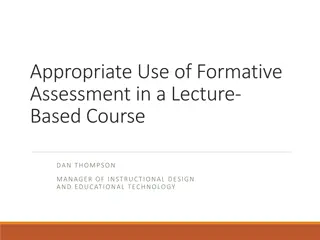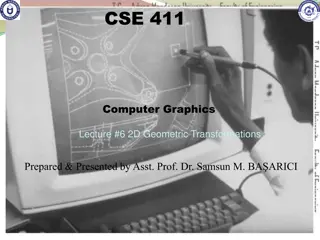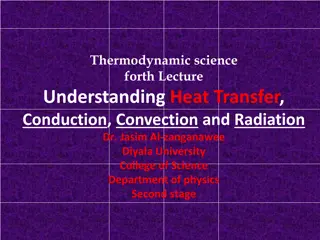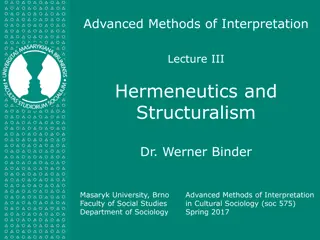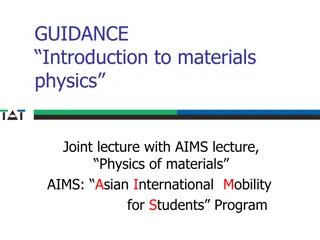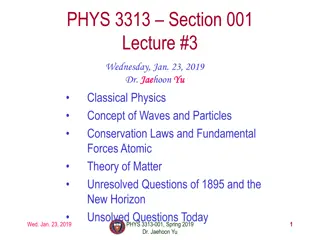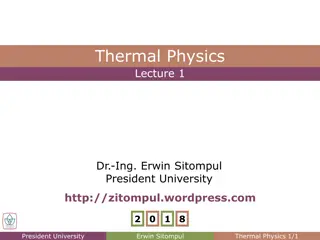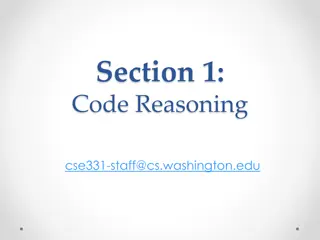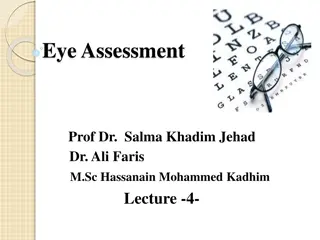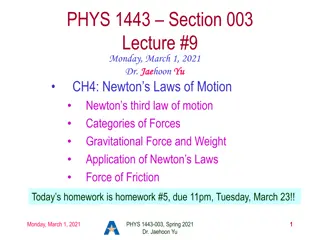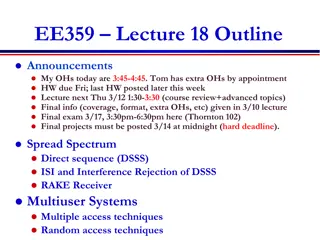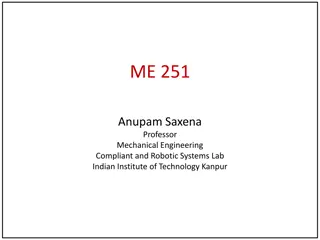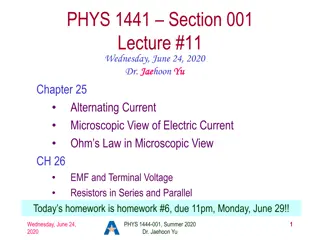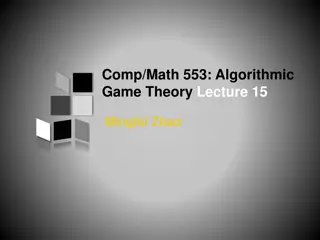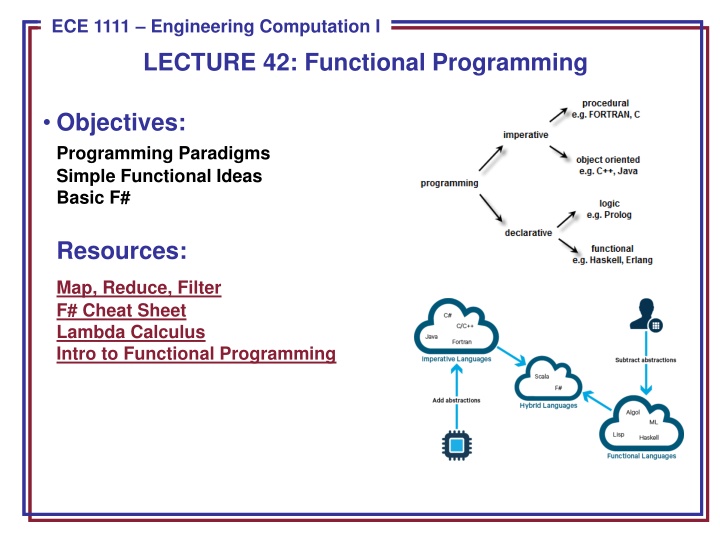
Functional Programming in Engineering and Computation
Explore the benefits and core concepts of functional programming in engineering and computation, including immutability, higher-order functions, and no side effects. Understand why functional programming leads to fewer bugs, simpler code, and easier scalability. Dive into key terms such as mapping, reducing, recursion, and currying. Discover how functional programming differs from imperative approaches through examples and comparisons.
Download Presentation

Please find below an Image/Link to download the presentation.
The content on the website is provided AS IS for your information and personal use only. It may not be sold, licensed, or shared on other websites without obtaining consent from the author. If you encounter any issues during the download, it is possible that the publisher has removed the file from their server.
You are allowed to download the files provided on this website for personal or commercial use, subject to the condition that they are used lawfully. All files are the property of their respective owners.
The content on the website is provided AS IS for your information and personal use only. It may not be sold, licensed, or shared on other websites without obtaining consent from the author.
E N D
Presentation Transcript
ECE 8443 Pattern Recognition ECE 1111 Engineering Computation I LECTURE 42: Functional Programming Objectives: Programming Paradigms Simple Functional Ideas Basic F# Resources: Map, Reduce, Filter F# Cheat Sheet Lambda Calculus Intro to Functional Programming
Programming Paradigms Imperative Object Oriented Declarative Functional F# Scheme ECE 1111: Lecture 42, Slide 1
Why Should I Use Functional Programming? Fewer Bugs Code Simpler/More Maintainable Code No Side Effects Easy to Parallelize & Scale Mathematically Provable Its been around a while ECE 1111: Lecture 42, Slide 2
Functional Core Concepts ECE 1111: Lecture 42, Slide 3
Terms to Know Immutable Data First Class Functions Tail Call Optimization Mapping Reducing Pipelining Recursion Currying Higher Order Functions Lazy Evaluation Monad: A Monad is just a monoid in the category of endofunctors, what s the problem? ECE 1111: Lecture 42, Slide 4
Functional Programming a = 0 b = 2 sum = 0 def add(): global sum sum = a + b def add(a, b): return a + b No Side Effects Side Effects ECE 1111: Lecture 42, Slide 5
Higher Order Functions What s the difference between these? x = np.random.rand(10,) for i in range(len(x)): y[i] = x[i] * 5 x = np.random.rand(10,) y = map(lambda v : v * 5, filter(lambda u : u % 2, x)) Imperative Functional ECE 1111: Lecture 42, Slide 6
Higher Order Functions x = np.random.rand(10,) for i in range(len(x)): if(x[i] % 2): y[i] = x[i] * 5 else: y[i] = x[i] x = np.random.rand(10,) y = map(lambda v : v * 5, filter(lambda u : u % 2, x)) Functional Imperative ECE 1111: Lecture 42, Slide 7
Higher Order Functions x = np.random.rand(10,) for i in range(len(x)): if(x[i] % 2): y[i] = x[i] * 5 else: y[i] = x[i] x = np.random.rand(10,) y = map(lambda v : v * 5, filter(lambda u : u % 2, x)) Functional Imperative ECE 1111: Lecture 42, Slide 8
Higher Order Functions import functools x = [0, 1, 2, 3, 4] ans = functools.reduce(lambda a, b: a + b, x) Functional Python 3.5 x = [0, 1, 2, 3, 4] sum(x) Imperative x = [0, 1, 2, 3, 4] ans = reduce(lambda a, b: a + b, x) Functional Python 2.5 ECE 1111: Lecture 42, Slide 9
Tail Call Recursion def factorial(n, r=1) : if n <= 1 : return r else : return factorial(n-1, n*r) Optimized Tail Recursive def factorial(n): if n==0 : return 1 else : return n * factorial(n-1) Tail Recursive ECE 1111: Lecture 42, Slide 10
Partial Functions Consider a function f(a, b, c); Maybe you want a function g(b, c) that s equivalent to f(1, b, c); This is called partial function application . import functools def log(message, subsystem): """Write the contents of 'message' to the specified subsystem.""" print('%s: %s' % (subsystem, message)) ... server_log = functools.partial(log, subsystem='server') server_log('Unable to open socket') ECE 1111: Lecture 42, Slide 11
Whats Next? ECE 1111: Lecture 42, Slide 12
Functional Basics with F# ECE 1111: Lecture 42, Slide 13
F# Syntax Cheat Sheets http://dungpa.github.io/fsharp-cheatsheet/ http://www.samskivert.com/code/fsharp/fsharp-cheat-sheet.pdf https://msdn.microsoft.com/en-us/library/dd233181.aspx http://en.wikibooks.org/wiki/F_Sharp_Programming ECE 1111: Lecture 42, Slide 14
History of F# F# OCaml C#/.NET Similar core language Similar object model 15 ECE 1111: Lecture 42, Slide 15
Imperative vs. Functional C# F# Imperative Functional ECE 1111: Lecture 42, Slide 16
What does functional even mean? Preferring immutability Avoid state changes, side effects, and mutable data as much as possible. Using data in data out transformations Try modeling your problem as a mapping of inputs to outputs. Everything is an expression! Too much |> ignore is often an anti-pattern Treating functions as the unit of work, not objects Looking at problems recursively Think of ways to model a problem as successively smaller chunks of the same problem ECE 1111: Lecture 42, Slide 17
Functional basics Immutability let x = 1 let mutable x = 1 x<-2 var x = 1; x++ let y = x+1 ECE 1111: Lecture 42, Slide 18
Declarative Style var vipCustomers = new List<Customer>(); foreach (var customer in customers) { if (customer.IsVip) vipCustomers.Add(customer); } Imperative var vipCustomers = customers.Where(c => c.IsVip); Declarative ECE 1111: Lecture 42, Slide 19
Functions int Add(int x, int y) { var z = x + y; return z; } } } } } } } } } int Add(int x, int y) { var z = x + y; return z; return z; return z; return z; return z; return z; return z; return z; return z; return z; return z return z return z return z z Add(x, y) { var z = x + y; var z = x + y; var z = x + y; var z = x + y; var z = x + y; var z = x + y; var z = x + y; var z = x + y; var z = x + y; var z = x + y var z = x + y let z = x + y let z = x + y let z = x + y z z Add(x, y) { { { { { { let z = x + y let z = x + y x + y add(x, y) add(x, y) add x y let add x y = let add x y = let add x y = let add x y = let add x y = let add x y = let add x y = let add x y = let add x y = let add x y = let add x y = let add x y = let add x y = x + y int Add(int x, int y) { var z = x + y; return z; } } int Add(int x, int y) { var z = x + y; return z; } int Add(int x, int y) { return x + y; no parens no curly braces colons equals of var no semi let and let instead no return no types camel case and commas Func<int,int,int> int -> int -> int In Out In Out ECE 1111: Lecture 42, Slide 20
Pipeline Operator let filter (condition: int -> bool) (items: int list) = // let filteredNumbers = filter (fun n -> n > 1) numbers let filteredNumbers = numbers |> filter (fun n -> n > 1) let filteredNumbers = numbers |> filter (fun n -> n > 1) |> filter (fun n -> n < 3) ECE 1111: Lecture 42, Slide 21
Currying //normal version let addTwoParameters x y = x + y //explicitly curried version let addTwoParameters x = // only one parameter! let subFunction y = x + y // new function with one param subFunction // return the subfunction val printTwoParameters : int -> (int -> unit) // now use it step by step let x = 6 let y = 99 let intermediateFn = addTwoParameters x // return fn with // x "baked in" let result = intermediateFn y // normal version let result = addTwoParameters x y ECE 1111: Lecture 42, Slide 22
Partial Application let sum a b = a + b Returns int = 3 let result = sum 1 2 Returns int -> int let result = sum 1 Returns int -> int let addOne = sum 1 Returns int = 3 let result = addOne 2 Returns int = 4 let result = addOne 3 ECE 1111: Lecture 42, Slide 23
Composition let addOne a = a + 1 let addTwo a = a + 2 let addThree = addOne >> addTwo let result = addThree 1 Returns int = 4 ECE 1111: Lecture 42, Slide 24
Functional basics: Higher-order functions [1..10] |> List.filter (fun x -> x % 2 = 0) |> List.map (fun x -> x + 3) |> List.sum let sumEvensPlusThree = Array.filter (fun x -> x % 2 = 0) >> Array.map (fun x -> x + 3) >> Array.sum sumEvensPlusThree [|1..10|] [|1.0;2.;3.;4.;5.;6.;7.;8.;9.;10.|] |> Array.filter (fun x -> x % 2. = 0.) |> Array.map (fun x -> x + 3.) |> Array.sum [|1..10|] |> sumEvensPlusThree let plus_3 x = x + 3 let list_plus_3 = List.map plus_3 let filtered = List.filter (fun x -> x % 2 = 0) [1..10] |> filtered |> list_plus_3 |> List.sum ECE 1111: Lecture 42, Slide 25
Work with Higher Order Functions What is the sum of the numbers 1 to 100, each squared? What about the sum of just the even numbers? Write a function that takes any list of floats and a function as an input. Add 10.25 to each element Divide each element by 4 Finally act on the list with the function you sent in. ECE 1111: Lecture 42, Slide 26
Higher-order functions: Answer ECE 1111: Lecture 42, Slide 27
The Iterator and Disposable patterns in F# F# provides the use keyword as an equivalent of C# s using statement keyword (not to be confused with C# s using directive keyword, whose F# equivalent is open) In F#, seq is provided as a shorthand for IEnumerable Your preference for collections should be (in descending order): list, array, seq ECE 1111: Lecture 42, Slide 28
What is polymorphism? Subtype polymorphism: when a data type is related to another by substitutability Parametric polymorphism: when code is written without mention to any specific type (e.g., list of X type, array of X type) Ad hoc polymorphism: when a function can be applied to arguments of different types Overloading (built-in and/or custom) Haskell: type classes F# specific feature: statically resolved type parameters ECE 1111: Lecture 42, Slide 29
Continuation Passing Style (a.k.a. Callbacks) Hey, when you re done doing that Explicitly pass the next thing to do Provides a method of composition of functions that can alter control flow More common than you may realize (we ll come back to this ) Very common in Javascript as well ECE 1111: Lecture 42, Slide 30
Blocking I/O and You the reason for Async The operating system schedules sequential operations to run in a thread If code requires external I/O, the thread running that code will block until it is complete This is bad ECE 1111: Lecture 42, Slide 31
Example of a blocking operation ECE 1111: Lecture 42, Slide 32
Your Web Server, Running Blocking I/O ECE 1111: Lecture 42, Slide 33
Continuation Passing Style (a.k.a. Callbacks) ECE 1111: Lecture 42, Slide 34
Continuation Pas Style (a.k.a Callback Hell) ECE 1111: Lecture 42, Slide 35
F# Async to the Rescue! ECE 1111: Lecture 42, Slide 36
Lets start from the beginning ECE 1111: Lecture 42, Slide 38
Lets start from the beginning ECE 1111: Lecture 42, Slide 39
Lets start from the beginning ECE 1111: Lecture 42, Slide 40
Lets start from the beginning Hey, these look like callbacks! ECE 1111: Lecture 42, Slide 41
Remember ECE 1111: Lecture 42, Slide 42
Additional libraries of interest FsCheck: https://github.com/fsharp/FsCheck Canopy: http://lefthandedgoat.github.io/canopy/ FAKE: http://fsharp.github.io/FAKE/ Paket: http://fsprojects.github.io/Paket/ Type Providers: Powershell: http://fsprojects.github.io/FSharp.Management/PowerShellProvider.html FSharp.Data: http://fsharp.github.io/FSharp.Data/ FSharp.Configuration: http://fsprojects.github.io/FSharp.Configuration/ ECE 1111: Lecture 42, Slide 43
General resources Me! Team leads Slack - #fsharp channel F# chat on SO http://fsharp.org/ Twitter: #fsharp F# channel on Functional Programming Slack Additional reading F# for Fun and Profit F# Weekly Try F# General Resources & Additional Readings ECE 1111: Lecture 42, Slide 44





